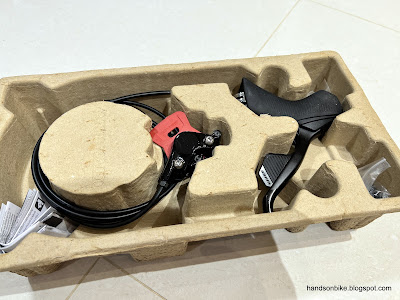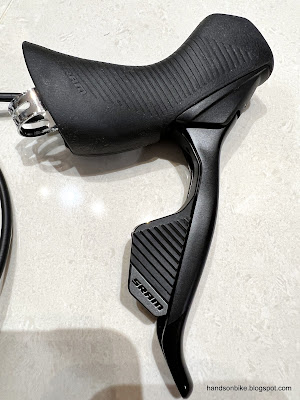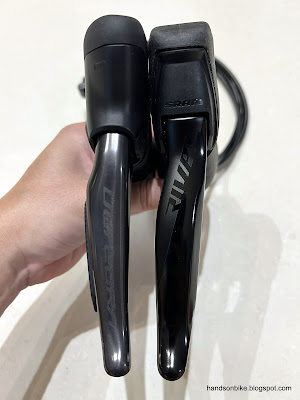For those who have not used SRAM road components before, here is a brief introduction. At the very top level, there is SRAM Red, followed by Force and then Rival. All 3 of these groupsets already have full wireless shifting, with no wires required anywhere.
Each of the shifters has its own coin battery, while the front and rear derailleur has a battery attached to each of them. Although it is a bit more troublesome to charge or replace many different batteries, it is super easy to setup. I liked how easy it was for me to setup the SRAM Force AXS rear derailleur and SRAM GX AXS shifter on the Fnhon DB12 folding bike.
I recently had the chance to study the SRAM Rival eTAP AXS road shifters and hydraulic brake caliper close up. Check out the detailed photos below to learn more about it!
The shifters and brakes are well packed, but there is so much empty space in the box. The Shimano equivalent takes up less than half the space.
It comes with many small parts for the brake calipers.
The Connecting Insert and Olive has a different design to the Shimano version. The Olive shape is different, and so you will need to use a compatible Connecting Bolt to match the Olive shape. The SRAM Olive is also red in colour instead of a natural brass colour.
Next, the Connecting Insert screws into the hydraulic hose, instead of being pressed in. This set comes with its own Torx tool to screw in the Connecting Insert.
Flat Mount bolts are available in 2 different lengths to fit different frames. This is for mounting on the rear chain stay.
The set comes with the hydraulic hose and brake caliper already attached and properly bled. It may sound convenient to come in this condition, but it is actually not.
Practically all modern road bikes have some sort of internal cable routing for the brake hoses, therefore it is never possible to assemble this pre-bled shifter and brake set onto the bike directly. The Shimano J-Kit setup has the system pre-bled as well, but the hose is not connected to the shifters. This allows the hose to be routed internally through the frame first, before being connected to the shifters. Most likely there is some patent issue that prevents SRAM from using the same setup.
In this case, it will be necessary to disconnect the hose from the shifter or brake caliper first, before routing it through the frame. After that, the Connecting Insert and Olive needs to be changed before it can be reconnected. This would be quite annoying as oil tends to leak from the end of the hose after disconnecting, making it messy to route the oily hose through the bike frame, fork or handlebar.
Weight of the shifter, brake caliper and hose, fully bled is 419 grams. It is heavier compared to the Dura-Ace version which is only about 330 grams for a similar setup.
The brake caliper does come with an adapter to offset the brake caliper from a rear 140 mm rotor to rear 160 mm rotor.
Brake pads are already installed and ready to go.
The brake calipers are quite ordinary, with nothing special to take note of. It basically uses the same construction as most of the other mainstream hydraulic brake calipers.
The shifters are more interesting, as it is always a challenge to fit the hydraulic parts inside, together with the electronics. It becomes even harder if you need to fit mechanical shifting components inside the shifter bracket.
Overall view of the SRAM Rival eTap AXS shifters. It only requires one button, as one side activates a lower gear, while the other side activates a higher gear.
The Rival logo is laser marked and anodized onto the aluminum lever member.
The rubber hood covers the axle of the brake lever, which gives a cleaner appearance. The front and back of the hoods are nearly parallel which makes it more comfortable to grip.
The electronics are completely contained behind the shifter button. There is a small mode button which is used to pair the shifter or for gear adjustments.
I like the modern design of this wide button, with the ridges and texture providing good grip.
Front view of the shifters. Both the bracket and the brake lever have a matte surface texture.
The shifter hood shape is actually quite similar. Shown here is the Rival eTap AXS vs the Ultegra R8170 shifters.
To me, both have similar grip ergonomics as the hood shape and size are similar.
The Rival brake lever has a bigger outward offset, as it does not have the 10 degree shifter tilt found on the Ultegra shifter.
The internal construction of the SRAM shifter is even more interesting, as it is very different from the Shimano design. I have previously taken a close look at the internal construction of Shimano road shifters.
There is a banjo bolt and a short section of hose, which links the master cylinder of the brake system to the external hydraulic hose.
This aluminum adapter is used to join the external hydraulic hose to the shifter. On a Shimano shifter, the threads are molded directly into the resin bracket.
This special banjo bolt enables the oil route to turn 90 degrees while maintaining a flat profile.
Other side of the shifter, with the rubber hood removed. There is actually lots of empty space as seen by the multiple ribs.
The larger bolt is used to secure the banjo bolt to the resin bracket, by pulling it from the other side of the bracket. The lower bolt is the axle of the brake lever. All nicely hidden by the rubber hood.
Reservoir cover is secured by 3 screws. Lots of information laser marked onto the bracket.
Bleed port at the top of the shifter. The master cylinder is an aluminium part that is inserted into the resin bracket.
Brake lever reach adjustment is done through this small hole in the shifting lever/button.
The coin battery is located at the bottom of the shifter body.
Also, they use different hydraulic fluids. SRAM uses DOT fluid while Shimano uses mineral oil. These different fluids require seal rings of different materials, which is why they are not cross compatible.


























IMHO Shape (leavers) are totally different, in upper grip Sram fiat very uncomfortable, and require more finger power to brakes system. Ultegra fits well and more „like a nature”. But its my opinion
ReplyDelete